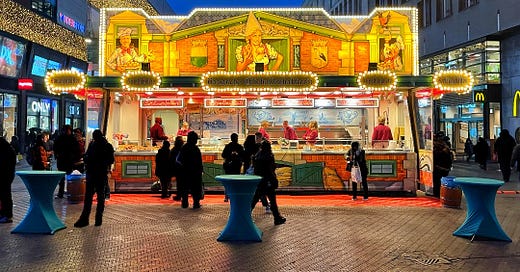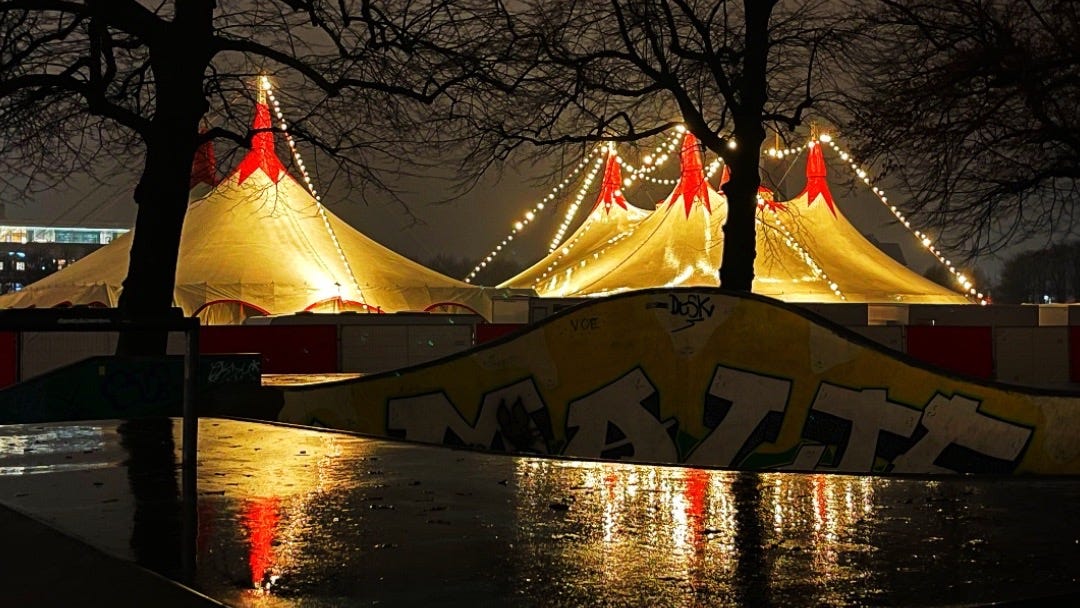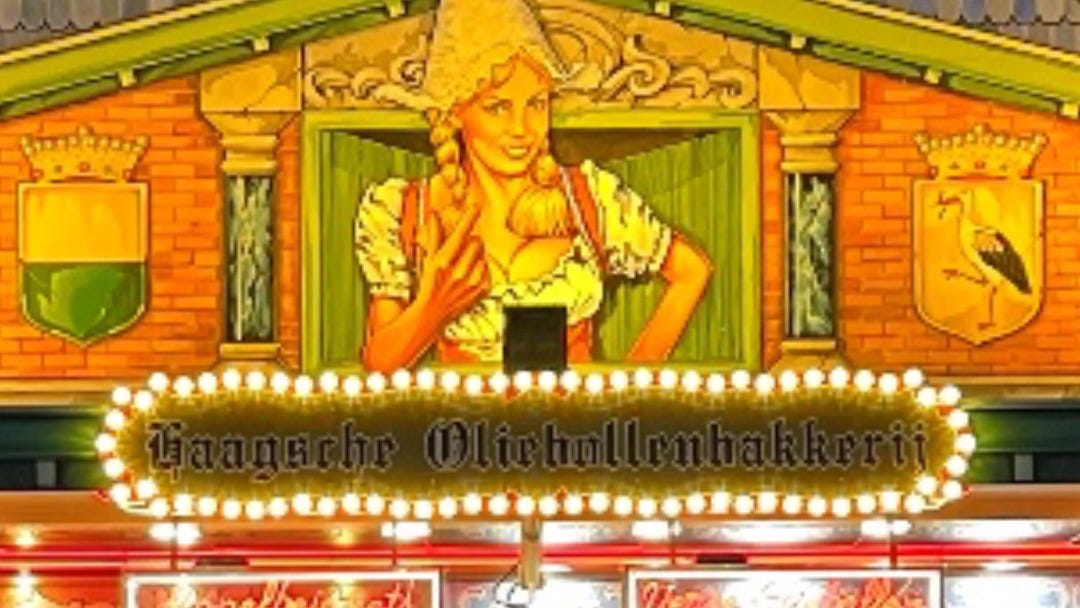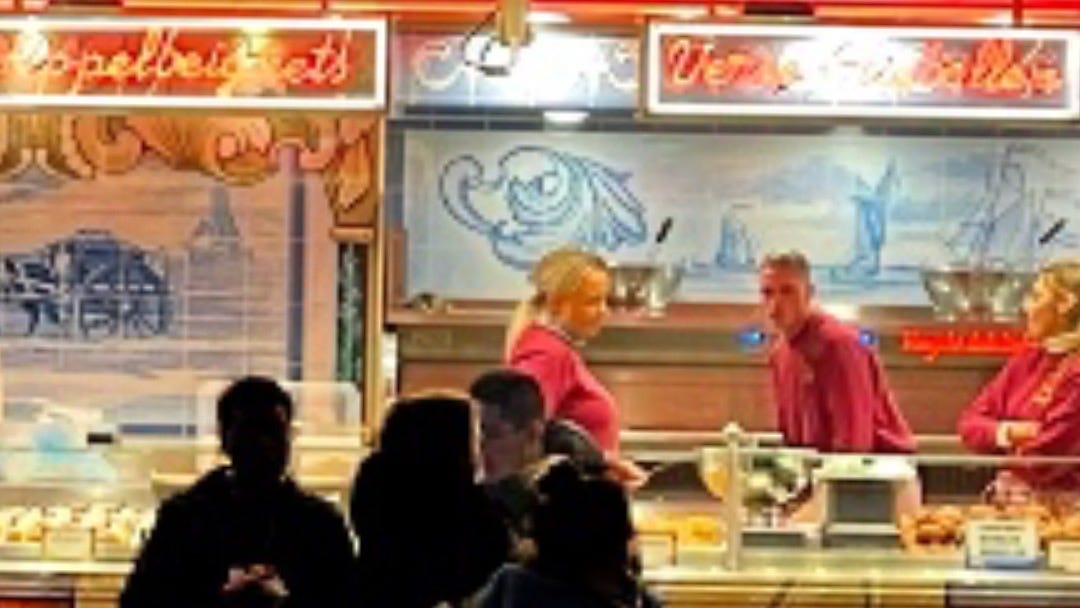I had planned to finish my wastewater project of podcasts and articles but changed my plans this morning and went to The Hague instead. It is one of the places in the Netherlands where I feel at home; I have lived here three times for several years between the early 1990s and 2015.
It's 10 p.m., and I'm back home in the cozy island house after driving through the darkness and rain, where I sit on the couch with my laptop. Due to the constant rain in The Hague, I photographed less than I usually do. Besides, it is the shortest day of the year in the Northern hemisphere, so I have only two rainy and pretty dark photos to share.
Malieveld
I took the first photo on the Malieveld, the vast open field that connects the forest to the city of The Hague. It's a favorite spot for massive demonstrations against government policies and a popular site for festivals, pop concerts, or building a tent like this. I suppose the circus is in town; when I passed, it was too dark and wet to check. But I just like the colors, lights, and contrasts in composition and mood.
So is this photo for you mainly dark, cold, and rainy? Or do you instead see the warm glow of the tent where people warm up while they drink hot chocolate and enjoy the show and each other's company? What you see in this photo may reveal more about yourself than about The Hague.
The Eighty Years' War
In the past, the Malieveld was part of the forest to the north and was also full of trees. At the start of the Eighty Years' War, part of the forest was cut down to protect The Hague against the Spaniards. The wood was used to build defenses. However, it was too late. The Hague had never received city rights, so there were no walls or ramparts. As a result, the Hague was virtually indefensible and was quickly taken by the Spaniards.
There were, and still are, some trees left on the side of the field. That is where I took this photo, and probably not many people will realize when they walk at this spot on the unremarkable "Koekamplaan" that what they see today would likely still be recognized if someone from the days of the Eighty Years' War with Spain would turn up today.

For example, look at this drawing from 1730 (some 150 years after the forest was cut): the two guys in red coats on the left are standing precisely where I took the photo of the tent this evening. I remember it so clearly since I searched for the right spot between the trees so that you could still see a few tree silhouettes but could also see the tent while it was reflected in the puddle of water on a block of concrete.
Once, the well-to-do of The Hague played a game on the Koekamp-lane that has some resemblance to golf or croquet. This "malie-game" explains the name of the Malieveld. It is the field next to the Koekamp-lane you see in the drawing. History is fascinating; it is everywhere, and that is especially true in European cities.
Oliebollenkraam
And this is the other photo I took: an "Oliebollenkraam" in the center of The Hague. Again, I loved the contrast of light and dark, the cozy traditional central theme contrasted with the cold modern buildings, and the details when you zoom in.
Here are a few details. Sorry if the pixels get a bit grainy by zooming in too much.
Well, like my earlier remark on the previous photo, it depends significantly on yourself what detail to focus on; I see two details. First, there is the beautiful word "Oliebollenbakkerij." Likely a short one for Germans, but in most other languages, this lengthy word must sound fascinating. If this interests you, look at what I wrote last year in this article about the similar term "oliebollenkraampjes."
The second detail to focus on is the stork in the coat of arms of the city of The Hague. If you visit The Hague someday, keep an eye out for the storks, you see pictures of them everywhere.
Dutch Delft tiles
Then, look at the Dutch Delft tiles (by now, the zoomed-in photo quality gets terrible). The original purpose of the Dutch Delft tiles was as wall tiles for the interiors of fireplaces. In the sixteenth century, fireplaces had developed into true works of art, but they were permanently blackened by the smoke. So wall tiles gave a bright and sparkling look while being able to withstand the heat and being simple to clean.
Not long after the Dutch discovered that the same wall tiles were also beneficial on walls susceptible to humidity stains, more and more fireplaces began to be decorated with the most exquisite tiles. The city of Delft is just minutes from The Hague; don't ever visit The Hague without visiting the historic town of Delft, where Vermeer painted his masterworks.
And here, a bird steals an "oliebol"; they must be tasty.
That's it for today; it's getting late. But before you go: If you want an original Christmas present, please consider giving a subscription to The Planet to a friend or family member. Then, you won't have to look further to find a nice present, your friend or family member will enjoy it all year, you make me happy, and you will always have a conversation topic with your friend or family member. What's not to like about that idea? Just click on this button; it takes half a minute:
Thank you for supporting independent writing!
Or take a subscription yourself:
Subscribers receive all articles and can comment via this button:
And if you don't like any of these options, you can always just tip the writer by buying a cup of coffee:











I look forward to the book you'll write one day.
What we see in a work of art and how we interpret that information indeed says volumes more about us than the view.
Thank you Alexander !
I love the Christmas lights and miss the Oliebollen (-:
Stay warm
Here we entering an Arctic deep freeze for 2 days. I'm hunkering down in a -20F Expedition sleeping bag!